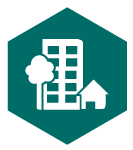Planning Department staff collaborate with residents, businesses, other City departments, boards and commissions, City Council, and other key partners to produce plans to shape an Austin where everyone can thrive. Each document provides a community-informed roadmap to achieve particular goals and visions for areas ranging in scale from the entire city down to specific neighborhoods.
Comprehensive Plan
![]()
Imagine Austin, the City’s comprehensive plan, guides the City in preparing for and managing expected population and employment growth through land use and public facilities investments.
Neighborhood Plans

Neighborhood planning provides an opportunity for community members to shape the neighborhoods where they live, work or own property, while addressing land use, zoning, transportation and urban design issues. Find a list of adopted planes, neighborhood contact teams, and other resources here.
Area Plans
- Downtown Austin Plan
-
The Downtown Austin Plan is both an inspiring vision and a detailed action plan for Downtown. It recommends steps to help Downtown become even more economically vibrant, livable, walkable, mobile, inclusive, diverse, and culturally alive – while preserving authentic Austin character.
- Palm District Plan
-
The Palm District Plan guides future development in the eastern edge of Downtown, linking land use, urban design, transportation, economic development, housing, public spaces, historic preservation, cultural arts, and social equity.
- North Burnet/Gateway
-
The North Burnet/Gateway 2035 Plan, adopted in 2006 is the result of a focused planning process aimed at tackling growth challenges in the area in North Austin bounded by Walnut Creek on the north, Metric Boulevard on the east, US 183 (Research Boulevard) on the south and southwest, Braker Lane on the northwest, and MoPac (Loop 1) on the west.
- East Riverside Corridor
-
The East Riverside Corridor Master Plan serves as the foundation for future zoning and design standards specifically for the East Riverside Corridor and guides future decisions regarding public infrastructure investments and private sector development and redevelopment.
- Equitable Transit-Oriented Development
-
Equitable Transit-Oriented Development Planning (ETOD) provides a comprehensive framework to guide future development around transit. It helps the Austin community ensure that the Project Connect transit system supports residents of all incomes and backgrounds, especially those who have been disproportionately burdened by transportation and land use decisions. ETOD planners have so far produced a new zoning overlay and two station area plans for the North Lamar Transit Center and South Congress Transit Center.
- Transit-Oriented Development
-
Transit-Oriented Development (TOD) is an intentional mixing of land use and transit through the creation of compact, walkable, mixed-use communities within walking distance of a transit stop or station. The goal is to bring together people, jobs, and services designed in such a way to make it efficient, safe, and convenient to travel on foot or by bicycle, transit, or car.
- South Central Waterfront
-
The South Central Waterfront Initiative promotes a vision and a set of recommendations, tools, and programs to guide redevelopment in the area just south of Downtown along Lady Bird Lake over the next 20 years.

